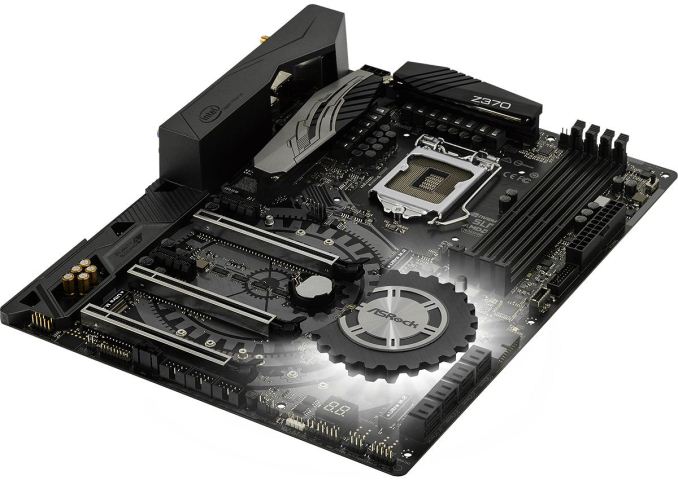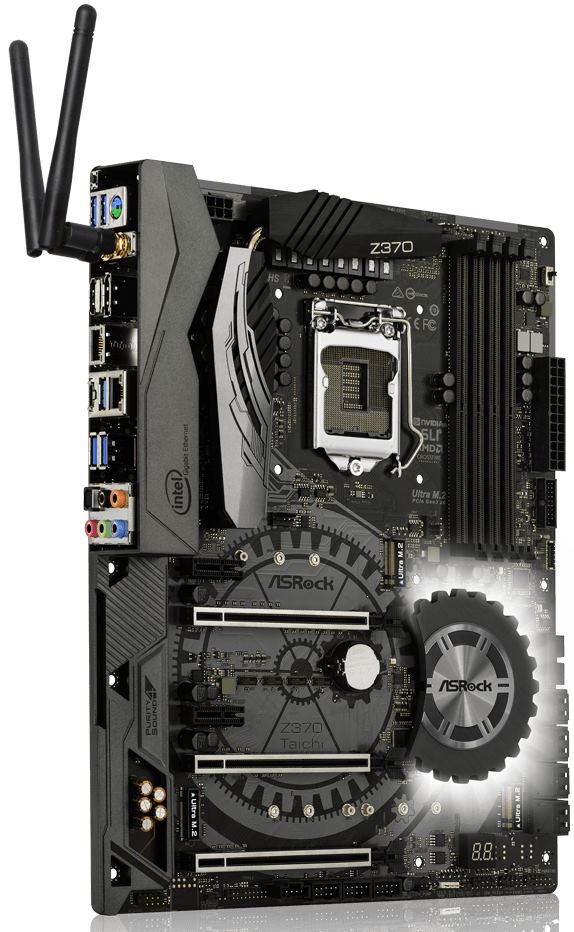The ASRock Z370 Taichi Motherboard Review: Competitive at $220, Aggressive at $190
by Joe Shields on July 20, 2018 1:15 PM ESTConclusion
The ASRock Z370 Taichi motherboard is designed to wear any number of hats in regards to what it can do. There are enough features on the board from multiple storage options to dual NICs and SLI/Crossfire capabilities which make this a well-rounded motherboard fit for nearly any job. Its $220 price tag lands the board in the mid-range price point for the platform but is met with a lot of competition from other board partners.
Overall the ASRock Z370 Taichi is a jack of all trades board with eight total SATA ports, three M.2 slots for high-speed storage, dual Intel NICs (I219-V and I211-AT), Wi-Fi, as well as back panel and front panel USB 3.1 ports. The board uses the latest Realtek ALC1220 codec along with a second amplifier for the front panel ports. The power delivery handled the stock and overclocking tests without issue and should be able to handle any ambient overclocking without concern with its heat pipe connected dual heatsinks keeping the area cool.
The overall performance on the Z370 Taichi was right where we expected in most tests landing in some area of the bell curve. This is the first review on the Z370 platform that utilizes a Spectre/Meltdown patches in the OS as well as the BIOS/microcode updates in the motherboard. Where we saw differences in, and in a positive way, are more than likely attributed to the new testing methodology, but for the sake of argument we're not putting too much weight on them until we test a few more motherboards. It will be interesting to see what the next review results are. The board excelled in our UEFI POST test setting the bar for the other boards to beat posting the quickest POST time yet.
The ASRock Z370 Taichi has proved itself performing well in our testing as well as keeping up with overclocking. The feature set is long and will provide users with a very good platform to build a PC with around the $220 price point. Other boards around that price include the MSI Gaming Pro Carbon AC ($190), the ASUS ROG Strix Z370-E Gaming ($200), and the GIGABYTE Z370 AORUS Gaming 7 ($230). Each board will have different features from the number of USB ports to PCIe slots, to the level of RGB LED illumination, but only one board includes dual NICs plus Wi-Fi, eight SATA ports, back panel and front panel USB 3.1 ports/headers, and that is the Taichi which solidifies this as one of the more feature-laden boards at its price point which should place the board on the short list at the ~$200-$230 price bracket.
Actually, at the time of publishing (7/20), Amazon currently has the ASRock Z370 Taichi listed at a reduced price of $190. This makes the board an extremely attractive and competitive option.
AnandTech Intel 300-Series Motherboard and CPU Coverage
- The Intel Core i7-8086K Review: Testing Intel's Anniversary 5.0 GHz Turbo CPU
- The Anandtech Coffee Lake Review: Initial Numbers on the Core i7-8700K and Core i5-8400
- Analyzing Z370 for Intel's 8th Generation Coffee Lake: A Quick Look at 50+ Motherboards
- ($397) The ASUS ROG Maximus X Apex [LINK]
- ($250) The NZXT N7 Z370 [LINK]
- ($219) The ASRock Z370 Taichi (this review)
- ($191) The SuperO C7Z370-CG-IW [LINK]
- ($180) The ASRock Z370 Gaming-ITX/ac [LINK]
- ($180) The ASUS Z370-I Gaming [LINK]
- ($124) The GIGABYTE H370N WIFI [LINK]
- ($120) The GIGABYTE B360 Gaming 3 WIFI [LINK]












32 Comments
View All Comments
inighthawki - Friday, July 20, 2018 - link
Ah yes, a PS/2 port. I see their 2018 models are cutting edge. Please include a nice parallel port as well for my printer.stuffwhy - Friday, July 20, 2018 - link
While it's use cases are very very rare nowadays, I can see much more potential for someone to have an old favorite keyboard than desperately have to use an old parallel port printer or peripheral. Heck, anything requiring a parallel port probably wouldn't even have driver support in Windows 10.Gasaraki88 - Friday, July 20, 2018 - link
This comment shows how much you know about technology and cutting performance. Most new gaming motherboard have a PS/2 port for the mice. PS/2 gaming mice perform better than USB. Please keep up with the times.inighthawki - Friday, July 20, 2018 - link
By a negligible amount, unless maybe you have 10 USB devices plugged in stressing the entire bus all at the same time. You're talking about an absolutely negligible difference in latency and processing time for a gaming rig.GTVic - Friday, July 20, 2018 - link
It's not negligible to ASRock if the consumer purchases the competitor's motherboard because ASRock's board didn't have this feature.anon94582 - Sunday, July 22, 2018 - link
And it cost negligible to add while provides added service to consumers who use PS/2 mouse/keyboard.BoneHurtingJuice - Friday, July 20, 2018 - link
In my experience, PS/2 keyboard/mouse combo ports are finicky at best. I couldn't get my programmable cash register keyboard to be detected at all on these ports.Kraszmyl - Friday, July 20, 2018 - link
The ps2 port is for gamers and their keyboards. They are technically better than USB ones.DanNeely - Friday, July 20, 2018 - link
A number of newer USB gaming keyboards will use a high end keyboard driver model for n-key rollover instead of the baseline USB-1 implementation that only supported 5 keys, taking away the mash keys like crazy advantage that PS2 used to have.baka_toroi - Friday, July 20, 2018 - link
>instead of the baseline USB-1 implementation that only supported 5 keysFor fucks sake. I always thought it was a membrane keyboard thing, not a protocol-level thing.